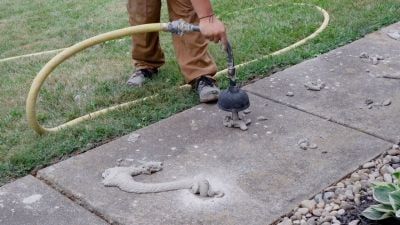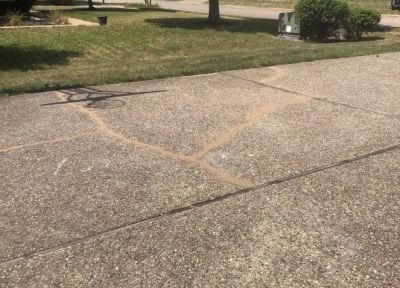
Learn how these five main factors influence how much you can expect to pay for safe, level concrete.
Concrete leveling can save up to 70% off the cost of replacement – that’s big savings! But that’s also pretty general.
The truth is, figuring out exactly how much you’ll spend on a concrete leveling repair is tricky without an experienced professional opinion. That’s because there are SO many variables that influence pricing!
In this article, we’re using our 30+ years in the concrete leveling industry to break down these variables. By the end, you’ll have a better idea of where your repair may fall on the pricing spectrum and be able to determine whether or not it will work for your budget.
Looking for concrete leveling pricing? Check out this resource: Ultimate Concrete Leveling Cost Guide (2024)
Factor #1: Size of the Repair
The bigger the repair, the more time and material will be needed to complete it – meaning larger repairs are usually more expensive.
How Far the Concrete Slab Has Settled
Part of what makes up the size of a repair is how far the concrete has sunken or settled.
More material and time are usually needed to lift a slab that has settled 4 inches compared to one that has only settled 1.5 inches.
How Many Concrete Slabs Need To Be Lifted
The number of concrete panels that need to be leveled also impacts the size of the repair.
While it may only seem like one sunken slab is the problem, oftentimes multiple adjoining panels also need to be lifted to achieve the proper grade or a smooth transition.
In this photo, you can see that while the stairs (#1) are obviously in need of a lift, slabs #2 and #3 will need to be lifted as well to ensure a smooth transition.

The Size of Voids Underneath the Concrete
As concrete settles, voids and empty spaces open up beneath the slabs. In order to lift the concrete and provide a stable base for it to sit on, those voids are filled during the concrete leveling process.
Larger, deeper voids will require more material and time to fill, making the overall size and cost of the repair greater.
Pro Tip: Measuring the concrete’s surface area is NOT an effective way of determining concrete leveling pricing.
By only relying on surface area, you’d miss important details, like the depth of voids, how much needs lifting, and the number of slabs that require attention.
Factor #2: Accessibility of the Area
How easy it is to get to the site with settled concrete will also impact concrete leveling pricing – the easier to access, generally the less expensive the repair will be.
Physical Obstacles in the Way
If concrete leveling technicians have to maneuver around complex obstacles, the repair generally costs more than if it were a straightforward lift with nothing nearby.
Here are some common physical obstacles we see regularly that can affect pricing:
| Posts/Railings | Construction | Other |
|---|---|---|
|
|
|
Distance From the Road or Driveway
A job site that is far from the road or driveway (where the concrete leveling truck and equipment usually stay for the duration of the repair), the repair may cost more.
This higher cost accounts for having to potentially run hoses through houses and buildings and drive through yards to get to the site.
Distance From the Business's Shop Location
Drive time and fuel costs also influence the overall cost of a concrete leveling job. A rural site that is far from the main shop will take longer and cost more to access than a nearby site, therefore the repair will usually be more expensive.
Factor #3: Material Used To Lift Concrete
There are three main types of concrete leveling, and they each use a different material to lift settled slabs back into place. These materials play a big role in the final cost.
Natural materials used in the stone slurry grout and mudjacking methods are usually much less expensive than the synthetic chemical foams used in the polyjacking process, which usually causes the repair to be less expensive overall.
Locally sourced natural materials, like pulverized limestone, can also support local economies and reduce transportation costs (which would otherwise be passed on to customers).

Factor #4: Cost of Living in Your Area
A big reason that it’s hard to pinpoint concrete leveling pricing without an estimate is that the cost of living changes depending on where you are in the country.
The cost of labor, fuel, and materials varies from region to region, and all of these variables will impact the final cost where you live.
The price ranges in our concrete leveling pricing guide take this into account, which is part of the reason the ranges are so wide.
Factor #5: Crack Repair Needs
Concrete cracks and gaps need to be caulked after a concrete leveling repair is complete. This is crucial in preventing water from entering through the cracks and eroding away the soil underneath the concrete leveling repair, which can cause the concrete to resettle.
Caulking is an important part of routine concrete maintenance, and without it, your concrete leveling repair likely won’t be covered under a warranty.
Caulking cracks is usually included in the price of a concrete leveling repair, but if you have a larger number of cracks that need to be caulked, it will cause the final cost of the concrete leveling repair to increase.

Cracks May Also Add Complexity
In addition to crack repair and caulking needs, broken concrete may be more difficult to lift because it has more pieces and may not move as easily, which may require more time to lift, resulting in increased costs.
How Much Will Concrete Leveling Cost You?
While the five factors mentioned in this article are a good starting place to determine how much concrete leveling will cost you, they are just that – a starting place.
To get an accurate idea of how much you’ll really pay, you’ll need an inspection and estimate from an experienced professional.
You can use our concrete leveling cost guide to get an idea of price ranges, and with what you’ve learned in this article, you’ll be able to better determine whether you are on the higher or lower end of the pricing spectrum.
If you’d like to skip the guesswork and learn exactly how much concrete leveling will cost you, click the link below to request a free onsite cost estimate with an A-1 Concrete Leveling expert near you!
Click Here to Find Your Nearest Location and Receive a FREE Estimate
Sarah Etler joined A-1 Concrete Leveling after receiving her Bachelor of Arts degree in English from Northern Kentucky University. As A-1's Content Marketing Manager, she works closely with industry experts to produce content that will best answer questions related to concrete repair and maintenance practices. Sarah loves living a life full of discovery and is excited every day to see what new things she can learn and share with those around her.
Topics: